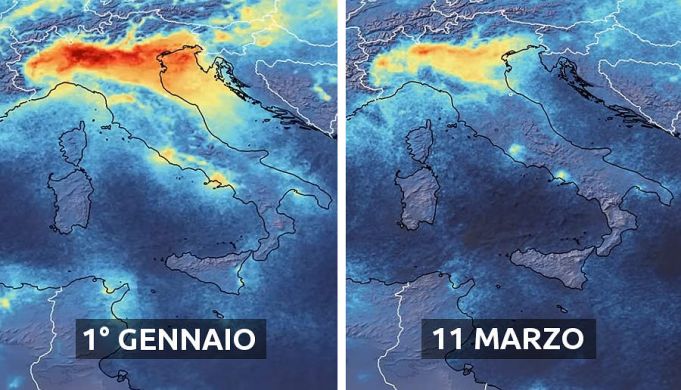A Positive Side Effect of COVID-19
"The reduction in emissions that we can see coincides with the lockdown in Italy causing less traffic and industrial activities.”
On 10 March, Italian Prime Minister Giuseppe Conte implemented a nationwide lockdown that has now affected all 60 million Italian citizens. Most everything in Italy was shut down, and everyone was ordered to remain indoors, only leaving for essential trips with a document of self-declaration. Streets that were once filled with bustling traffic and zooming Vespas are now vacant. Grey doors barricade restaurants and cafés that once spilled out with people socializing and drinking strong expresso, while munching on sweet cornetti. The Italian lifestyle has changed.
Venice
Other aspects of Italy have changed, as well. Since the implementation of Conte’s lockdown, the frequently visited Venetian canals have seen a dramatic drop in boat traffic. This sudden decrease cleared the typically murky water, until it was a bright blue-green. From the surface, fish are visibly swimming around, and swans have taken to relaxing on the now calmed water. Nature is returning to Italy, especially to the overwhelming Italian cities, and there have been more positive effects.
Images from Space
After a couple of days in lockdown, the European Space Agency’s Copernicus Sentinel-5p satellite brought back new atmospheric data.
With the ability to measure the concentration of greenhouse gases and other pollutants in the atmosphere, the satellite showed a drop-in air pollution, from 1 January to 11 March. Nitrogen gas, an especially harmful pollutant that increases the risk of asthma, lung inflammation and other health issues, has been especially affected. Concentrations of this poisonous gas that is typically emitted from cars, power plants and other industrial sources fell approximately by 40 percent.

This clearing of pollutants was mostly observed over northern Italy, most notably around Milan. These changes are especially important in this area because this area is one of western Europe’s pollution hotspots. The Alps at the end of Po Valley tend to trap smoke emanating from factory clusters in northern Italy. To Vincent-Henri Peuch, director of the Copernicus Atmospheric Service, this change is “quite unprecedented.” Past data collections have shown variations similar to this one. However, the weather played a major role in previous readings of resembling variations, but no one trend has lasted this long.
Some continue to attribute these changing levels of nitrogen dioxide to cloud coverage and changing weather. Yet, Claus Zehner, the mission manager of the European Space Agency’s Copernicus Sentinel-5p satellite, has observed that “the reduction in emissions that we can see coincides with the lockdown in Italy causing less traffic and industrial activities.” This observation has lead researchers to believe these factors are the contributing sources. However, there has not been a positive identification of any one origin.
In Europe
Satellites are beginning to detect similar variations in other big European cities headed into lockdowns, similar to that of the Italian lockdown. With these new observations, the European Space Agency will be able to monitor the situation. After a longer period of time, more data can be collected and studied. With this data, the European Space Agency will be able to confirm this pattern: lockdowns lead to a decrease in human activity, which then leads to a decrease in atmospheric pollutants.
















